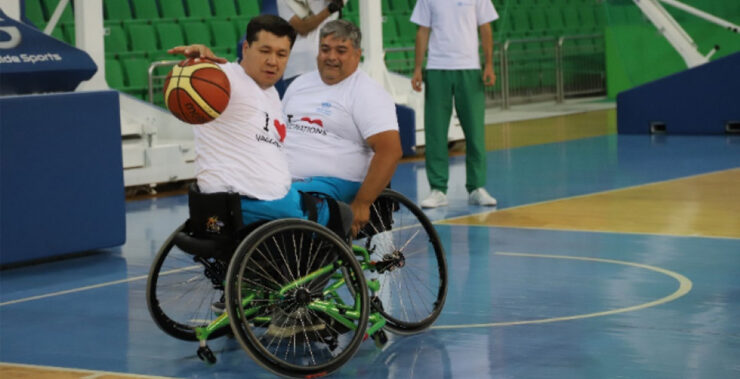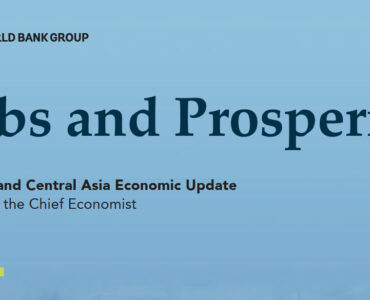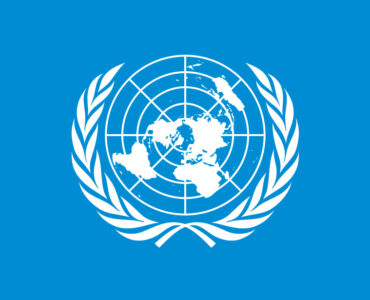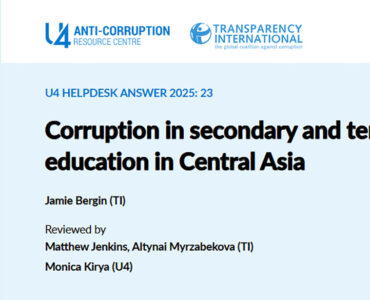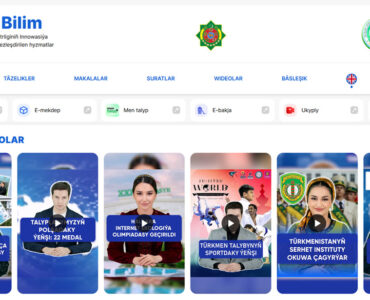The purpose of this overview is to provide brief yet comprehensive information relevant to the situation of persons with disabilities in Turkmenistan including national laws and programs, international obligations and statistics. An extensive list of all sources, reports and institutions is provided at the end. The desk research is structured according to the articles of the Convention on the Rights of Persons with Disabilities (CRPD), which is the key international human rights treaty to protect the rights and dignity of persons with disabilities. As a party to the Convention (since 2008) Turkmenistan is required to promote, protect, and ensure equality and the full enjoyment of human rights by persons with disabilities.
However, concluding observations from the CRPD in 2015 highlight several persistent challenges that Turkmenistan needs to address including – adopting a rights-based approach to disability which ensures for equal right and access to education, employment, healthcare, social services, sexual and reproductive health services, voting rights, accessible infrastructure, gender equality, equal pay as well as collecting comprehensive data on disabilities, combating stigma and discrimination against children with disabilities and providing legal mechanisms to address rights violations of people with disabilities.
Article 4 – General obligations:
According to the 2022 State Report to CRPD, since March 13, 2021 the Code of Turkmenistan on Social Protection of the Population defines a person with a disability as a person with a permanent physical, mental, intellectual or sensory impairment which, when interacting with various barriers, may prevent him or her from fully and effectively participating in society on an equal basis with others.
However, there are remaining concerns based on the 2015 Concluding Observations:
- The State party takes a medical approach to determining disability, instead of a social and human rights model for disability (Code of Turkmenistan on social protection of the population).
- The State party has not clarified how the definition of disability is binding upon enterprises, institutions and organizations, especially in the field of employment.
- Lack of sufficient information on the legal safeguards and remedies available in case of a violation of the rights of persons with disabilities.
- The State Party needs to ensure the involvement of experts from the social, labor and education fields on the assessment panels determining disability.
- The State party should further provide clear legal safeguards and remedies, as well as related procedures, for cases of violations of the rights of persons with disabilities.
According to State Report to CRPD 2022 data:
- The number of persons with newly diagnosed disabilities in Turkmenistan in 2015 was 10,709 people, in 2016 – 12,082, in 2017 – 12,831, in 2019 – 12,656, in 2020 – 12,369, in 2021 – 12,045 people.
Article 5 – Equality and non-discrimination
According to COMMON COUNTRY ANALYSIS (CCA) 2022,
- isolation from society and discriminatory attitudes toward persons with disabilities are less commonly identified problems, mentioned by 6% of adults and 8% of children.
According to the 2019 Situational Analysis on Youth in Turkmenistan A UN Inter-Agency Initiative,
- classification of any type of persons with disabilities as “unemployable” continues negative stereotypes and promotes socio-professional insertion.
Article 6 – Women with disabilities
According to 2024 Women with disabilities in Turkmenistan claim their rights:
- Despite international agreements safeguarding reproductive choices, women with disabilities encounter obstacles in accessing sexual and reproductive health services (relevant to A.25).
- Biases among health professionals, intimate partners, and the public often question the decision-making capacity of women with disabilities regarding their sexual and reproductive health (relevant to A.5)
Article 7 – Children with disabilities
According to COMMON COUNTRY ANALYSIS (CCA) 2022, Early Child Development Index (ECDI), among children aged 3-4 with disabilities:
- Developmental Tracking: only 27% are developmentally on track.
- Social-Emotional Development: 68% exhibit progress in this domain.
- Physical Development: 79% are on the right path.
- Learning: 30% show advancement.
- Reading and Numeracy Skills: merely 7% demonstrate proficiency in these areas
Children with disabilities, especially those in urban areas and with functional difficulties, frequently experience emotional stress, helplessness, loss of interest, apathy, and other negative emotions. Around 6% of children with disabilities are frequently under such emotional stress.
According to Analysis of Situation of Children’s and Women’s Rights in Turkmenistan, 2019
- Turkmenistan has a low share of children in institutions in comparison with other ECA states.
- The number of children in institutions has increased however from 2398 in 2005 to 3716 in 2016, which is mostly due to the increase in the numbers of children with disabilities placed there.
- Introduction of rehabilitation centers has led to an increase in the number of children placed in residential institutions.
- According to one UNICEF study, the biggest reason for placement of children into infant homes is refusal of parents because of disability and temporary placement for reasons of the child’s disability.
- 62% of the population of the infant homes constitute children with disabilities.
Article 8 – Awareness-raising
According to COMMON COUNTRY ANALYSIS (CCA) 2022, equal rights awareness:
- Among Adults with Disabilities: The awareness level among adult respondents with disabilities regarding their rights and benefits appears high:
- 25% feel they know their rights very well, while 64% believe they know them sufficiently.
- However, 8% have poor knowledge, and 3% are completely unaware of their rights and privileges.
- Among respondents for children with disabilities: Awareness of international documents for legal protection, such as the CRC and the CRPD, is low among respondents forchildren with disabilities, with only 54% familiar with each document. Conversely, familiarity with the normative and legal documents in Turkmenistan is higher.
According to the 2019 Situational Analysis on Youth in Turkmenistan A UN Inter-Agency Initiative:
- references to persons with disabilities are not yet common across all existing programmes for socioeconomic development and other national strategies and programmes for economic, political and cultural development.
Article 9 – Accessibility
According to the OSCE report: PARLIAMENTARY ELECTIONS 26 March 2023:
- Polling stations are largely inaccessible to voters with mobility challenges.
- Home voting is offered but falls short of fully accommodating individuals with disabilities.
- Essential resources like braille templates for visually challenged voters are lacking.
- The Central Election Commission (CEC) shows limited awareness of inclusive measures, such as using sign language for voter education.
According to 2024 Women with disabilities in Turkmenistan claim their rights:
- Research by UNFPA in 2021 revealed that many individuals with disabilities in Turkmenistan struggle to obtain sexual and reproductive health services and information.
According to Analysis of Situation of Children’s and Women’s Rights in Turkmenistan, 2019
- Parents resort to placing their children in residential institutions due to the lack of locally available services and support for children with disabilities.
According to Statistics Committee: SDGs
In 2022, based on Ind. 4.a.1: Proportion of schools offering basic services, by type of service: d) infrastructure and materials adapted for students with disabilities:
- Total – 0.9%, Rural – 0.1%, Urban – 2.5%. Urban has decreased from 2.9% in 2015 to 2.5% in 2017 and remained the same until 2022.
- Ashgabat – 1.3%, Ahal velayat – 0.4%, Balkan velayat – 1.2%, Dashoguz – 0.6, Lebap – 1%. Mary – 1.2%.
According to COMMON COUNTRY ANALYSIS (CCA) 2022, usage of information and communication technologies (ICT) among adults with disabilities reveals:
- Internet Usage:Only 19% of adults aged 18 years or over with disabilities have ever used the Internet.
- Internet Activities: Among those who have used the Internet, the most common activities include listening and downloading music, video clips, movies (69%), and engaging in communication and games (67%).
- Internet Utilization: 56% of Internet users utilize it for obtaining information and 52% electronic services.
- Frequency of Internet Use: Among Internet users, 28% use it almost every day, while 30% did not use it at all in the past three months, indicating that only 5% are regular users.
- Mobile Phone Ownership: 78% of adult persons with disabilities own personal mobile phones. However, ownership varies significantly among individuals with different types of health disorders:
- Only 30% of individuals with speech disorders and 34% of those with mental disorders possess personal mobile phones, compared to 88% of those with physical disorders.
- Similarly, only 56% of individuals with functional difficulties own personal mobile phones, compared to 88% of those without functional difficulties.
Article 24 – Education
According to Voluntary National Review of Turkmenistan, 2020 survey:
- Education emerged as a notable difference between the two groups, with 8% of adults and 26% of children identifying it as a primary concern.
- The overall literacy rate among persons with disabilities aged 18 years and older stands at 86%.
- Regarding education, one-third of children with disabilities aged 3 to 17 attend regular educational institutions, while 12% are enrolled in special pre-primary and comprehensive schools.
According to the 2019 Situational Analysis on Youth in Turkmenistan A UN Inter-Agency Initiative:
- placement of children and adolescents with disabilities in regular schools and their allocation to technical training schemes tend to be made by medical and educational assessment commissions instead of on the basis of the existence/provision of accessible conditions in teaching facilities and students’ personal vocational choices.
According to Analysis of Situation of Children’s and Women’s Rights in Turkmenistan, 2019
- Children with disabilities encounter significant obstacles in mainstream education, including a lack of trained teachers and physical inaccessibility.
- Some mainstream schools exhibit resistance to accommodating children with disabilities, hindering their integration.
Article 25 – Health
According to COMMON COUNTRY ANALYSIS (CCA) 2022, access to healthcare services for persons with disabilities faces significant challenges:
- Financial Accessibility: 61% of persons with disability encounter difficulties obtaining paid services due to financial constraints, while 16% find them completely inaccessible.
- Physical Accessibility: Distance to medical facilities poses a barrier, with 6% of persons with disability finding them completely inaccessible and 28% partially inaccessible.
- Other Accessibility Issues: Access to specialized medical professionals (24%), facilities with ramps and handrails (25%), and quality services (20%) are also limited for persons with disability
- Need for Assistance: 23% of persons with disability require assistance at home, while 22% need it outside of home. Family members predominantly provide assistance (98% at home, 97% outside), with a smaller percentage receiving help from healthcare workers or individual assistants. Some (15%) rely on assistance from outsiders.
Quality and availability of health care services are frequently cited as problems by 21% of adults and 17% of children.
Article 27 – Work and employment
According to COMMON COUNTRY ANALYSIS (CCA) 2022, employment among persons with disabilities presents varied statistics:
- Current Work Status: only 14% of adult persons with disabilities are presently employed, while 29% have previously held jobs.
- Non-Employment: 57% have never been employed.
- Regional Disparities: In Ahal velayat, 98% of persons with disabilities are not working, with 81% having never worked.
- Challenges for Certain Groups: individuals with intellectual and mental impairments are particularly marginalized, with 97% currently unemployed.
According to Statistics Committee: SDGs
In 2022, based on Ind. 8.5.1: Average hourly earnings of employees, by sex, age, occupation and persons with disabilities is 1714.2 TMT for women and 1962.3 TMT for men.
- In Turkmenistan, women with disabilities have been consistently paid the lowest due to their gender and disability. In 2022, women with disabilities received 87 percent of what men with disabilities earn and 72 percent of what men without disabilities earn.
Article 28 – Adequate standard of living and social protection
According to COMMON COUNTRY ANALYSIS (CCA) 2022, both adults and children with disabilities face similar challenges:
- Low levels of pensions and allowances are identified as a major issue by 35% of adults and 38% of children.
- Impact of Functional Difficulties: Presence of functional difficulties significantly affects life satisfaction, with persons experiencing such difficulties less satisfied compared to those without, at 77% versus 92%.
According to Analysis of Situation of Children’s and Women’s Rights in Turkmenistan, 2019
- Social services lack consistency and universal availability, with coordination issues among service providers and partners.
According to Analysis of Situation of Children’s and Women’s Rights in Turkmenistan, 2019
- Families may not be aware of the benefits of caring for children with disabilities at home, leading to a preference for institutional care.
- Many families find it financially challenging to access rehabilitation and social services, particularly due to the high cost of travel.
- While families receive financial assistance, it may not adequately address the need for home-based care and support.
According to Statistics Committee: SDGs
In 2021, based on Ind. 1.3.1:
- Proportion of disability pension recipients in the total population: 0.7%
- Proportion of recipients of state disability benefits in the total population: 2%
- Children in them under 18 aged with disabilities: 0.4%
According to State Report to CRPD 2022 data:
- As of 2022, the number of recipients of pensions and disability allowance is 179,6 thousand, of which the number of children under 18 is 24 thousand.
- In 2022, average monthly pension and disability allowance was 630,8 TMT equal to USD 180,22 USD on the official rate and USD 32.5 on the black market rate (19.4 TMT in 2022)
Article 29 – Participation in political and public life
According to the OSCE report: PARLIAMENTARY ELECTIONS 26 March 2023:
- Laws still limit voting rights for those with mental disabilities, which violates international norms and contradicts the CRPD.
- The CEC lacked information regarding whether any individuals with disabilities ran for election.
Article 31 – Statistics and data collection
- In 2022, Turkmenistan undertook a large census, 2022 Complete Population and Housing Census of Turkmenistan, for the first time including people with disabilities in the survey. However, only a fraction of census data is available online and none of what is available online relate to people with disabilities.
- Same year, UNICEF and the government of Turkmenistan conducted Survey results of Children and Adults with Disabilities. Like the census, the report itself is not available online.
- While there are attempts to address the existing concerns, lack of comprehensive and disaggregated data does not allow to monitor and evaluate the changes as well as understand where Turkmenistan currently stands.
Relevant Programs implemented:
In 2024, based on Women with disabilities in Turkmenistan claim their rights
- UNFPA, in collaboration with the Society of the Blind and Deaf of Turkmenistan, developed sexual and reproductive health videos with sign language interpretation to cater to the needs of individuals with disabilities.
- These videos, accessible online and via flash drives, address various topics including puberty, family planning, and safe motherhood.
- Efforts are underway to develop a mobile application to further enhance accessibility to sexual and reproductive health information for individuals with disabilities.
In 2022, based on CCA 2022
Joint Inter-Ministerial Provision on Early Intervention Services:
- Developed to support cross-sectoral continuum and quality of early intervention services for young children with disabilities and their families.
- Implemented as part of the National Early Childhood Development (ECD) Strategy for 2020-2025.
- National capacities were developed for early identification of developmental delays and disabilities among young children.
- Inclusion of district-level Primary Health Care (PHC) clinics in Dashoguz and Mary velayats increased the share of etraps providing early intervention services to under 5 children to 18% in 2021.
Professional Training Initiatives:
- Over 200 PHC professionals were trained in early identification of developmental delays.
- UN collaborated with the National Red Crescent Society to train over 50 Red Crescent volunteers in Infant Young Child Feeding and Early Childhood Development.
- A course on social inclusion for persons with disabilities was developed as part of the undergraduate medical-social work curriculum at Turkmen State Medical University.
- Training program for transdisciplinary specialists to provide comprehensive early intervention support for young children with disabilities and their families was delivered for 150 childcare professionals from health, education, and social protection sectors.
- In-service training package included modules on transdisciplinary services, mental health, and communication.
- Core modules for a short in-service course on inclusive education were developed to support initial capacity building of pedagogical professionals in promoting inclusive learning environments, to be tested further in 2023.
Preparation for Census 2022:
- The UN provided preparation for Census 2022, including inclusion of migration and disability questions in the Census questionnaire to ensure alignment with internationally agreed standards.
Other Results from CCA:
- Introduction of 12 new types of specialized social services, including personal assistant services, piloted in various regions for families and individuals with different needs, such as children, elderly people, and individuals with disabilities.
In 2020, based on Voluntary National Review of Turkmenistan
Focus on Social Services:
- Special attention is given to social services for individuals who have partially or completely lost their ability to care for themselves.
- As of January 1, 2023, Social Service institutions catered to 2011 individuals, with 78.7% of them being women.
In 2019, based on Analysis of Situation of Children’s and Women’s Rights in Turkmenistan
Implemented Programs:
Specialized Institutions:
- Turkmenistan has established 15 specialized pre-school institutions and 17 special educational institutions for children with disabilities and special needs.
Disability Cash Transfers:
- Families with disabled children receive disability cash transfers based on the severity of the child’s disability, along with additional pensions until the child reaches 18 years old.
- Orphaned children and their caretakers benefit from special child allowances, providing financial support to vulnerable families.
Social Services Delivery:
Donate to support Turkmen analysts, researchers and writers to produce factual, constructive and progressive content in their efforts to educate the public of Turkmenistan.
SUPPORT OUR WORK- Social services, including medical care, parenting support, and early childhood development services, are delivered through various channels such as family doctors, parent centers, and early childhood development centers. However, these services lack consistency and universal availability, highlighting the need for improved coordination and accessibility.
National Laws, Programs, and State Institutions
Related State Agencies
The Institute of State, Law, and Democracy of Turkmenistan,
Ministry of Construction and Architecture,
State Committee for Television, Radio Broadcasting and Cinematography
Local executive authorities and local self-government bodies
Ministry of Foreign Affairs, Social sphere
Ministry of Finance and Economy,
Ministry of Internal Affairs of Turkmenistan
Road Transport Ministry
Agency for Transport and Communications,
Ministry of Health and Medical Industry.
Relevant articles:
- Disability issues and analysis of groups of populations that need help and support;
- Educational and Scientific Center for Maternal and Child Health of the State Medical University of Turkmenistan named after M.Garryyev;
- Dental training and production center of the State Medical University of Turkmenistan named after M.Garryyev.
Blind and Deaf Society
Ministry of Education of Turkmenistan,
Ministry of Labour and Social Protection,
List of Required Documents for Disability Pension
In accordance with paragraph 4 of part two of Article 33 of the Code of Turkmenistan on Social Protection of the Population, the following documents are attached to the application for the appointment of a disability pension by the conditional-cumulative method:
- copy of passport (substituting document);
- extract from the MSEC inspection report (Medical and social examination (expert commission) (MSEC)
- certificate of family composition;
- copies of birth certificates of family members under 18 years of age;
- documents confirming individual periods;
- a copy of the work book (or an alternative document);
- a copy of the certificate of state awards and honorary titles (for persons with state awards and honorary titles, which provide for additional payments);
- Details of the “Altyn Asyr” plastic card of the citizen applying for benefits.
National Laws:
Constitution of Turkmenistan, 2016, latest amendments 2023
Social Protection Code (2012): latest amendments 2022
- Provides state benefits for disabilities like temporary and permanent disability.
Law on State Guarantees of the Rights of the Child: 2014, latest amendments 2017
- Ensures children with disabilities have a decent life and active participation in the community.
Health Act: 2015, latest amendments 2023
- Guarantee free access to disability related healthcare and support services like physiotherapy and prosthetics.
Education Law 2013, latest amendments 2023:
- Promotes inclusive education and inclusivity in vocational colleges.
Employment Act, 2016, latest amendments 2018
- Offers additional employment guarantees for people unable to compete equally, including persons with disabilities.
Labor Code of Turkmenistan, 2009, latest amendments 2023
State Pension Insurance Law, 2012, latest amendments 2021
Social Services Law, 2022
Criminal Code, 1997, latest amendments 2023
Code on Administrative Offenses, 2014, latest amendments 2023
Law on State of Emergency, 2013
Law on Provision of Psychiatric Care, 2016
National Programs:
Programme for the Improvement of the Employment Provision System and the Creation of New Workplaces in Turkmenistan (2015–2020):
- Aims to expand employment opportunities for persons with disabilities.
Plan of Activities for the Provision of Full Realization of the Labour and Employment Rights of Persons with Disabilities in Turkmenistan (2017–2021):
- Focuses on ensuring labor and employment rights of persons with disabilities.
National Human Rights Action Plan (2021–2025):
- Devotes a section to ensuring rights of persons with disabilities as per the CRPD
National Socioeconomic Development Programme (2011–2030):
- Includes plans to improve social protection and support for persons with disabilities.
National DRR Strategy:
- Considers vulnerable groups like women, children, and persons with disabilities in disaster risk reduction.
National Early Childhood Development (ECD) Strategy for 2020-2025
- focuses on cross-sectoral collaboration to ensure survival and development of young children, and prioritizes early childhood care and education
National Plan of Action for Realization of Children’s rights in Turkmenistan (NAPC) 2023-2028
National Action Plan on Gender Equality for 2021-2025
National concept of inclusive education for 2023-2028 (IE)
- Developed in 2022 but not yet adopted?
Program of the President of Turkmenistan for the socio-economic development of the country for 2022-2028
- provides for structural reforms in the economy, creating new jobs, stimulating the development of small and medium-sized businesses, expanding employment in the private sector and transferring informal workers to the formal sector, which opens up new opportunities for the population, including persons with disabilities
New National Program for the Socio-Economic Development of Turkmenistan for 2022-2052
- priority of the Program is the ever-increasing role of human capital as the main factor in the economic development of the country and, as a consequence, the formation of a new social model of development that ensures high living standards for Turkmen citizens.
- Inclusion and equality to “leave no one behind”;
- Human rights, gender equality and labor rights, and women’s empowerment;
- Sustainability and resilience; and
- Accountability, including the availability and use of quality data.
Convention on the Rights of the Child (CRC): accession20 Sep 1993 (a)
Convention on the Elimination of All Forms of Discrimination Against Women (CEDAW): accession 01 May 1997
International Covenant on Economic, Social and Cultural Rights (ICESCR): accession 01 May 1997
International Covenant on Civil and Political Rights (ICCPR): accession 01 May 1997
Sendai Framework for Disaster Risk Reduction 2015–2030
ILO Conventions:
- In 2019, Turkmenistan adopted a resolution to accede to the ILO Convention “On Tripartite Consultation to Promote the Application of International Labor Standards” No. 144 (1976).
- In 2020, Turkmenistan acceded to the Convention against Discrimination in Education; and
- Marrakesh Treaty to Facilitate Access to Published Works for Persons Who Are Blind, Visually Impaired, or Otherwise Print Disabled.
- In 2021, Turkmenistan acceded to the ILO Employment Policy Convention No. 122 (1964).
Convention on the Rights of Persons with Disabilities (CRPD):
- Accession Date: 04 Sep 2008
- CRPD OP: Acceptance of individual complaints and inquiry procedures on 10 Nov 2010.
- Latest Report: Concluding observations in 2015, with the State Report submitted in October 2022.

